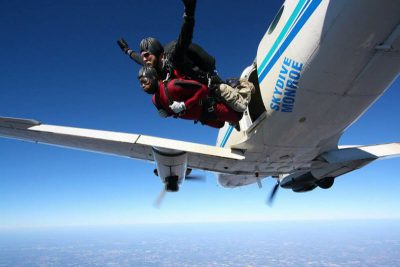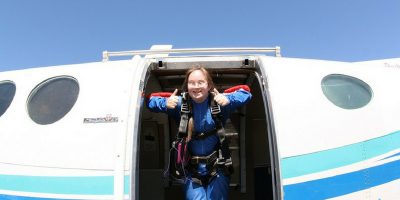While safety seems like the obvious answer for donning a helmet, skydivers opt to wear them for multiple reasons. From providing comfort and style to accommodating cameras that capture all the sickest moments of a skydive, helmets are generally part of a skydiver’s essential gear.
Keep reading to learn about what sets skydiving helmets apart from the other melon shields of the world, why some skydivers wear helmets, and why some don’t!
Do You Have To Wear A Helmet To Skydive?
 No, you do not need to wear a helmet to skydive, it is only required for those pursuing their solo skydiving license. A helmet is not required for licensed skydivers or tandem students. What happens if you skydive without a helmet? Nothing out of the ordinary!
No, you do not need to wear a helmet to skydive, it is only required for those pursuing their solo skydiving license. A helmet is not required for licensed skydivers or tandem students. What happens if you skydive without a helmet? Nothing out of the ordinary!
What’s so special about solo skydiving students who have yet to achieve their license – are their heads more important than others!? Ha! Simply put, they’re inexperienced! Solo students only have a handful of jumps, and protecting their noggin from the odd bump on the plane isn’t their top priority – jumping from the airplane is.
On another note, student jumpers are often guided by a radio during their solo parachute descent, and these radios are generally strapped to their helmet, ensuring they can hear direction crystal clear.
Top Reasons Skydivers Wear Helmets
If it’s not an actual requirement, why do jumpers opt to wear headgear? Functionality (and a little bit of safety)! Let’s dive into the pros of wearing a helmet while jumping.
Protection from Impact
Surprisingly, most skydiving helmets are not impact-rated. Whaaaat!? We know! When we say “protection from impact” we mean bumping your head on the plane door, into another jumper, or during a particularly tumbly landing. Skydiving holds some inherent risk (it’s an extreme sport, after all), and mitigating risk wherever possible is the mindset of skydivers far and wide.
Noise Reduction
Freefall is LOUD. When the wind is rushing past at 120+ mph, things can get a bit noisy and over-stimulating. Helmets aid in reducing this noise, making the skydive more enjoyable for most people. Although, some skydivers love hearing the rush of the wind – it’s a personal preference.
Mounting cameras
If we didn’t get sick footy, did it really happen? Skydivers love getting videos of their jumps to share with their friends, and most importantly to watch back and learn from. Licensed jumpers commonly debrief skydives after each jump or at the end of the day, and instructors do the same with students. Seeing your body position in freefall can help concepts to become more digestible and really click before incorporating them into the next jump.
Comfort
Feeling confident and comfortable during a jump is KEY! It’s not fun dealing with mid-air hair whipping across your face, or tangling in a way that prevents you from seeing clearly. Besides being flat-out annoying, unruly hair can be a snag hazard. Snag hazards are things on us that can catch on anything – the door of the aircraft, skydiving gear, etc. – this is the primary reason we strongly discourage wearing jewelry (particularly rings) during a jump.
Style
Many jumpers sport personalized hydro-dipped designs or loads of stickers on their dome defenders! Helmets come in various colors that help jumpers to express themselves and match their gear. Skydivers often say, “Look good, have fun, safety third.” For obvious reasons, this is a joke, but feeling good is definitely part of the mix for a successful jump!
Audibles
Many licensed jumpers skydive with more than one altimeter! Altimeters allow skydivers to remain aware in the sky by telling them how high up they are. Audible altimeters loudly beep in the jumper’s ear at preset altitudes, and these little devices are secured in a small pocket inside the helmet.
Full-Face Helmet vs Half-Helmet
Can I use a motorcycle helmet for skydiving? Sorry, bud – that’s a HARD no. Full-face helmets may look like motorcycle helmets, but they are simply not the same thing. Skydiving helmets are lightweight, designed to be easily removed, and have intentionally crafted ventilation priorities – ensuring they won’t fog up and prohibit your vision during the jump.
Half-helmets, or open-face helmets, are required for student jumpers. These bad boys require goggles to accompany them, as they don’t have a face shield to protect your eyes during freefall.
When can you wear a full-face helmet skydiving? Once you get your skydiving license! Many licensed jumpers opt for full-face helmets, but the ol’ open-face is common for those who like to feel the breeze on their face, and for videographers, who utilize their special designs to mount multiple cameras.
Will I Be Okay Tandem Skydiving With No Helmet?
 So, do you wear a helmet when skydiving if you don’t want to? Nope. As long as you’re not a solo skydiving student, it’s not an actual requirement, just a recommendation.
So, do you wear a helmet when skydiving if you don’t want to? Nope. As long as you’re not a solo skydiving student, it’s not an actual requirement, just a recommendation.
We’ve all seen videos or photos of jumpers with their hair flowing through the breeze, and no skull cap in sight, right? When you tandem skydive, you’re attached to a professional and experienced skydiving instructor – THIS IS WHAT THEY DO! Their job is to ensure you have the most fun and comfortable jump possible, meaning they will be watching your every movement and skillfully guiding you to avoid bumping your beautiful brain on anything.
Ready to feel the refreshing rush of freefall, the wind on your skin, and experience skydiving for yourself? The sky’s calling – book today!
Copyright © 2025, Skydive Monroe, All Rights Reserved.
DropZone Web Design & Marketing by Beyond Marketing, LLC



